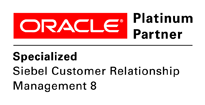Past Event: Nov 09, 2023
Retrouvez Boxfusion Consulting lors de l’événement Oracle Applications Unlimited Days, en France
1 min read
We have been working with Siebel Open UI for the last 3 years, in which time we have produced a steady stream of innovation and new approaches to improving Siebel usability. Working to drive process efficiency and reduce the overall cost of Siebel ownership, we have where possible shared this information with the Siebel community. In this blog we look at a new direction for Open UI innovation utilizing functionality that you may already be familiar with from such applications as Excel; we look at how you can create macros to shortcut repetitive tasks and increase your Siebel users' productivity.
Using only a custom Open UI View PR and PM, we have added functionality which allows the user to record a sequence of actions on a view, or in fact a number of views, and save these actions as a macro which can then be run whenever they require – perfect for saving time and effort when creating a common Service Request type for example, with a number of generic child activities which would otherwise need to be added manually.

The custom PR works by catching events fired on any of the applets on the view: events such as NewRecord, UndoRecord, FieldChange etc. These events along with which applet they were fired on, which control (if applicable) and any relevant field values, are saved as a macro, which for the purposes of this POC, is stored in a Web SQL database. There is, however, no reason to prevent us storing this data in Siebel tables instead, allowing the macro to be available to multiple users.
When the user selects this saved macro and clicks run, the PR executes the recorded events sequentially – in effect mimicking the actions the user performed whilst recording the macro.
For those familiar with vanilla quick fill templates in Siebel, this may sound like quite similar functionality. In effect we are doing the same thing by allowing the user to create a custom template to define which fields should be populated with which values. There are however, many benefits of using our custom Open UI approach over the vanilla quick fill templates:
As mentioned before, the functionality is implemented simply using one PR and PM. To be able to record actions on a particular view, the PR and PM must be associated to that view in the manifest administration. The PR and PM are generic, so it's as simple as associating the js files to the view in the manifest administration for each view you wish to have the functionality available.
Look out for our future blog posts about Siebel and Open UI or explore our other Open UI blog posts to gain a better understanding of how you are able to exploit  the benefits of Open UI to the full.
the benefits of Open UI to the full.
Alternatively, you can read more about our OpenUI Services here or contact us for further information!
1 min read
5 min read
5 min read